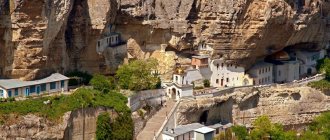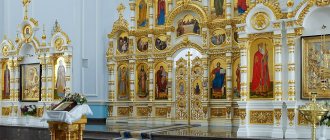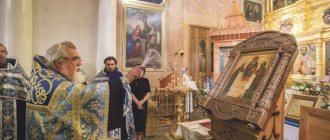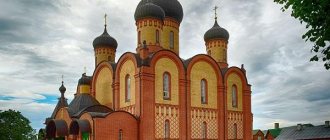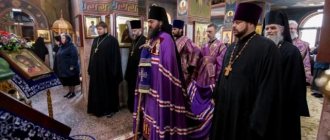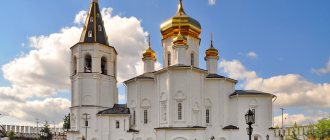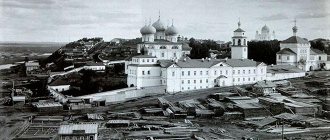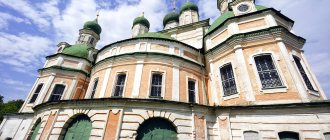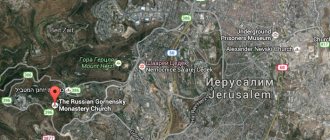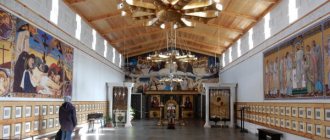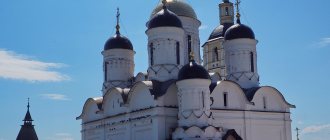Svyatogorsk Lavra is located in the Donetsk Republic of Ukraine - not far from the border of three regions: Kharkov, Donetsk, Lugansk, next to Slavyansk, not far from Gorlovka - the site of hostilities in 2014
“From so many centuries of existence of the local monastery, there are no legends left for us. Its chroniclers could not be people; the same angels wrote down deeds and exploits in the book of the belly!” Thus exclaims St. Innokenty (Kulchitsky), who has been here more than once. They say that the local mountains are named Saints because of the holiness of their inhabitants, of whom there are only 17 glorified ascetics, but the feat of dozens or even hundreds more is known only to the Lord.
Years of Soviet power
It is difficult to find at least one temple or monastery that would not have been damaged in one way or another when the Bolsheviks came to power at the beginning of the 20th century. A tragic fate befell the Svyatogorsk Lavra, the looting of which began immediately after the revolution.
One of the revolutionaries, on whose instructions a cinema and library were equipped in the monastery premises, was a certain Fyodor Andreevich Sergeev, known under the pseudonym “Comrade Artem”. He was an ideological revolutionary, an authoritative Soviet political figure. Today he is credited with the fact that the buildings and structures of the monastery were not destroyed.
Icon of the Cathedral of the Svyatogorsk Fathers
This is true, but this was done not out of respect for the spiritual heritage, but simply out of practical expediency - where monks lived, prayed and carried out spiritual feats quite recently, in 1922 a holiday home for Soviet workers of Donbass was founded. This year can be considered the year of the complete collapse of the monastery.
Interesting! Knowing about the sad fate of the monastery during the Soviet years, the monument to Artem looks somewhat absurd today, which rises very close to the holy places and is clearly visible next to the monastery.
In 1790, a new owner appeared in Svyatogorye, Prince Potemkin Tauride
In 1790, a new owner appeared in Svyatogorye; he became Prince Potemkin Tauride. Then, by decree of the Synod, the monastery churches of the Dormition of the Mother of God and St. Nicholas the Wonderworker became parish churches, while others were dismantled and taken away.
The Svyatogorsk monastery remained in this abolished state for almost 57 years. All these lands remained in the Potemkin family.
In 1790, Svyatogorye began to belong to the Potemkin Tauride family
Then in 1844, thanks to landowner Tatyana Potemkina, and by decree of Emperor Nicholas I, the monastery was restored. And over the next 70 years, it reached unprecedented prosperity. Then it became one of the largest in the Russian Empire.
But at that time the question of assigning the status of a monastery to the Svyatogorsk monastery was not raised. At that time, the monastery had workshops, mills, as well as various trade and workshop shops. It was also known for its wonderful views, which attracted many pilgrims.
Also at the end of the 19th century, at the site of the train crash of the imperial family, in the village of Borki, the Svyatogorsk Spaso-Svyatogorsk skete with the Cathedral of Christ the Savior was built. Before the First World War, there were about 600 monks in the monastery.
The current state and activities of the Lavra
Today, the Holy Dormition Svyatogorsk Lavra is a significant and influential Orthodox center for all of Ukraine and the surrounding regions of Russia. Unfortunately, the fratricidal war in Donbass, as well as the creation of a new schismatic Ukrainian church, could not but have a negative impact on the development of Orthodoxy in these lands.
But, nevertheless, the Lavra bravely stands in a difficult political and spiritual crisis, and the prayer for peace in Donbass and an end to the bloodshed does not cease.
Divine service in Svyatogorsk Lavra
In addition to spiritual work, the Svyatogorsk Lavra became an important center of social assistance: in 2014, when active hostilities began in the Donbass, it was here that about 1,000 refugees, including many children, found shelter and refuge.
To date, the Lavra has returned to its possession all the buildings and lands that rightfully belonged to it. Among the most important restored objects are:
- the Assumption Cathedral, which can be called the main center of the entire Lavra;
- Intercession Church and the bell tower of the monastery;
- the temple of Anthony and Theodosius of the Kiev-Pechersk, which is the oldest active temple of the monastery. In the monastery of this temple, with the special blessing of the ruling bishop, all the brethren dress in ancient monastic robes;
- on the tops of the chalk mountains, temples in honor of St. Nicholas the Wonderworker and Alexy, the man of God, have been completely restored and are functioning;
- All Saints wooden monastery, which carries not only spiritual value, but is also a real architectural monument, a unique example of wooden architecture;
- many caves, monks' cells, small cave temples and hermitages. Many of them are open to visitors today; they allow both tourist groups and religious pilgrims who want to pray in the ancient caves.
Separately about Svyatogorsk caves
The Holy Dormition Svyatogorsk Lavra, in addition to shrines and devotees of piety, is famous throughout the Orthodox world for its chalk caves. Dug by the first monks and settlers in these places, these caves remember the very beginning of monastic life in the Holy Mountains.
Today the Svyatogorsk caves are of both spiritual and cultural-historical interest. In a spiritual sense, ancient cells and temples located deep in the depths of the chalk mountains can tell us about the life, way of life, piety and prayer of the very first ascetics who dared to settle here many centuries ago.
Svyatogorsk caves
Some underground temples are still in operation today, so you can attend worship services in the caves. In addition, the cells of the monks who lived and lived in the monastery in various centuries are well preserved.
The total length of all caves is about a kilometer. The exact date of its occurrence is not reliably known. Some researchers talk about the very early appearance of chalk caves (approximately 8-9 centuries), and that they were dug not by Russian monks, but by settlers from other countries. According to other sources, the caves appeared in the 11th-12th centuries and were used as shelters during the then frequent raids of the Tatars and other enemies.
Among the most ancient cave rooms that have survived to this day are:
- Church of the Nativity of John the Baptist;
- Church in the name of Saints Anthony and Theodosius of Kiev-Pechersk;
- monastic cells;
- several household and utility rooms;
Interesting!
There is a legend according to which there is a secret underground passage connecting the monastery and the opposite bank of the Donets River. This is not known for certain, but given the defensive importance of the monastery, such a move could actually exist. The cave in which the Monk John lived in seclusion has not survived to this day. Unfortunately, chalk is a rather brittle mineral, which is why many ancient caves have collapsed. The safety of the underground passages of the Svyatogorsk Lavra is a pressing issue today.
Notes[ | ]
- ↑ 123
Svyatogorsk Assumption second-class male monastery of the Pskov diocese. - Svyatogorsk-Assumption Monastery // Encyclopedic Dictionary of Brockhaus and Efron: in 86 volumes (82 volumes and 4 additional). - St. Petersburg, 1890-1907.
- Pskov-Svyatogorsk Monastery in honor of the Dormition of the Blessed Virgin Mary in the village of Pushkinskiye Gory, Velikiye Luki diocese.
- Through his “care” a large bell weighing 151 pounds 10 pounds was cast. ( Geichenko S.S.
At the Lukomorye. L.: Lenizdat, 1971. P. 222) - Sheremetevsky V.V.
Gennady (archimandrite) // Russian biographical dictionary: in 25 volumes. - SPb.-M., 1896-1918. - The leadership of the Svyatogorsk Monastery illegally cut down trees on the hill where Pushkin’s grave is located - Metropolitan Tikhon. The abbot of the monastery has been relieved of his post (unspecified)
. Interfax-Religions (12/13/2019). Date accessed: December 14, 2019. - Journals of the meeting of the Holy Synod of March 11, 2022, Journal No. 26 (unspecified)
.
Patriarchia.ru
(11.03.2020). Access date: March 12, 2022.
About the shrines of the Lavra
Like any other holy place, the Holy Dormition Svyatogorsk Lavra has its own special shrines, which many Christian believers strive to touch. Of all the variety of shrines on the Holy Mountains, pilgrims especially strive to pray before the miraculous Svyatogorsk Icon of the Mother of God, as well as to visit the grave of St. John.
Svyatogorsk Icon of the Mother of God
In addition to any other Orthodox holidays common to the entirety of our Church, a huge number of pilgrims go to the Svyatogorsk Lavra on one more day - July 30. It is on this date that a solemn service takes place in honor of the Svyatogorsk Icon of the Mother of God, which is miraculous and revered both in the Donbass and beyond.
Before the outbreak of revolutionary unrest, there were two similar icons in the monastery. The first ancient image, unfortunately, did not survive and was lost during the destruction of the monastery. Another icon, which is a copy of an ancient one, is still kept in the Lavra. Pilgrims go to her.
Svyatogorsk Icon of the Mother of God
The current Svyatogorsk icon dates back to the 19th century. According to legend, an Athonite elder who came to the Holy Mountains saw the beauty surrounding him and began to greatly grieve that he could not leave any gift. Then he painted an icon, which he handed over to the monastery. The image was kept for a long time in an ancient cave church in honor of John the Baptist.
Interesting! Repeatedly, the icon was miraculously saved from destruction by water and fire. Despite all the negative influences, the image remained intact.
During the Soviet years, the icon was hidden by pious believers, and in 1992, during a religious procession, the image was solemnly delivered to the Assumption Cathedral. After this, many pilgrims began to come here, and through sincere prayers they received healing. On the image you can see many pendants, jewelry, chains - these are the gifts that people brought to the icon in gratitude to the Most Holy Theotokos for hearing prayers and answering them.
Tomb of St. John the Recluse
The name of St. John in the world was Ivan Kryukov. He was born at the end of the 18th century in the city of Kursk. From early childhood, the future saint was drawn to the monastic and reclusive life, but he was not able to realize his dream of special service to the Lord right away. First, he had to go through many life trials - a hungry, joyless childhood, and an unwanted marriage, forced by his parents.
Already an adult man, the future ascetic was widowed. Having resignedly endured the cross of everyday trials, he was finally able to get closer to what was most dear to his heart - life in a monastery. Ivan enters Glinsk Hermitage. From the very beginning of his monastic path, he was distinguished by his special zeal in prayer, the purity and sincerity of his soul.
After 7 years of constant labor, he was tonsured into the mantle under the name Ioannikios. Soon the Svyatogorsk Monastery began to be restored, and some monks from the Glinsk Hermitage moved to live there. Among them were the monk Ioannikis. Here he held the position of housekeeper, and brought many practical benefits to the restored monastery.
Icon of St. John, the Recluse of Svyatogorsk
The ascetic was attracted by the caves of the monastery, and with the blessing of the abbot, he went into seclusion in one of the chalk caves. After this, he was tonsured into the great schema under the name John.
The life of an ascetic was extremely meager and ascetic. He slept in an open wooden coffin, with a little straw instead of a bed. His cave was low, small and cold, and the light came from a small crevice in the rock. In addition, the ascetic wore chains and a hair shirt, which taxed his body even more, but exalted his spirit. Constantly remaining in prayer, strict fasting and efforts to curb his flesh, the saint only allowed himself a short rest for a short time.
The ascetic spent 17 years in the feat of seclusion, for which, even before his death, he was awarded many spiritual gifts from the Lord. The saint died peacefully and calmly, joyfully giving his soul into the hands of the All-Merciful Lord, whom he served faithfully throughout his adult life.
The monk was buried on the territory of the monastery, and the flow of pilgrims to his grave does not decrease. Immediately after his death, many received healings and other miraculous gifts through prayer. Soon the Monk John was canonized; today solemn services are served to him and many believers pray, receiving tangible help.
The grave of A. S. Pushkin in the Svyatogorsk Monastery
On the territory of the Orthodox church on Sinichya Mountain there is a tomb of the Hannibal-Pushkin family. The poet's mother was buried in the same monastery in 1836. Here, in 1837, Alexander Sergeevich himself was buried. For the first few years after the poet’s death, a wooden cross stood on his grave. In 1841 this tombstone was replaced with a marble monument.
© Lyudmila_Klyopova
